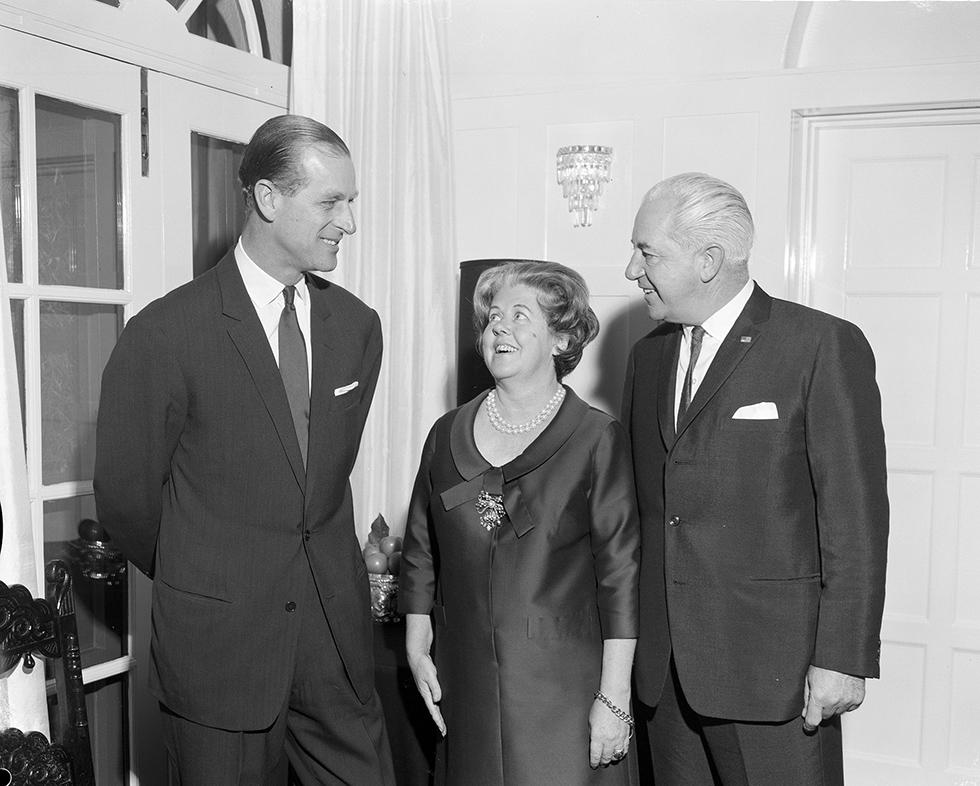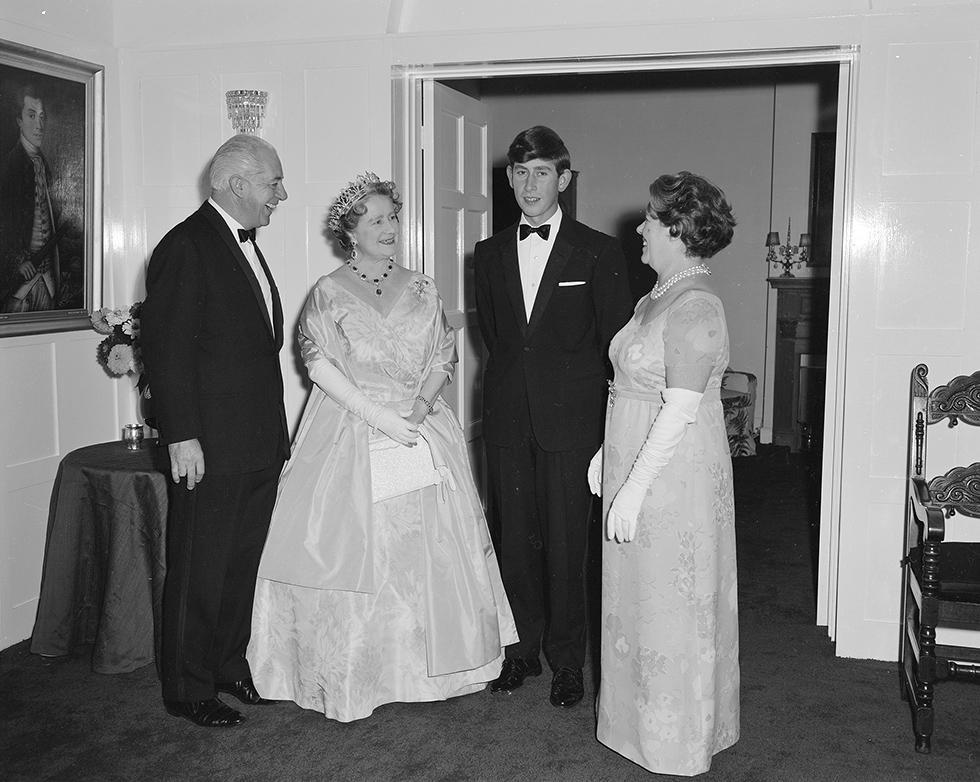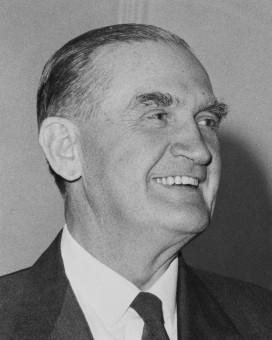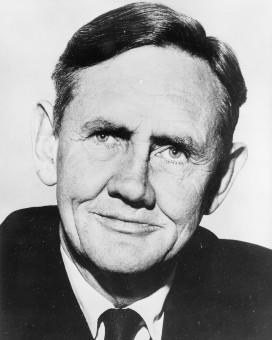As a ‘political wife’, Zara Holt brought a valuable dowry to her marriage to Harold Edward Holt. For 20 years before he became Prime Minister, her charm, candour and business connections fuelled his political career. As energetic a traveller and ‘meet-and-greeter’ as her husband, Mrs Holt played a significant role in weaving influential relationships. The detailed travel accounts she relayed to friends and family are key records in investigating the importance of that role.

Zara and Harold Holt with the Duke of Edinburgh, their guest at The Lodge on 6 March 1967. NAA: A1200, L60989
Although prime ministerial wife for only 2 years, Mrs Holt made a remarkable contribution to The Lodge. The Holts’ brief term of residence in 1966–67 marked the greatest activity in both renovation and decoration of The Lodge’s 40 years. Mrs Holt was the owner of the boutique ‘Magg’ in Melbourne’s wealthy suburb of Toorak, plus other salons in Melbourne and Adelaide, and brought a strong interest in fashion and design to her role as prime ministerial spouse.
For 2 months after Holt was sworn in as Prime Minister, Mrs Holt’s main preoccupation was an immediate refurbishment of the entrance foyer, and of the dining room and sitting room that led off each side of the foyer. Living at the Hotel Canberra, and impatiently awaiting the removal of the last of the Menzies’ possessions, Mrs Holt directed the refurbishment. It proved to be just the first stage of a remarkable transformation which eventually included interior reconstruction upstairs and down.
For stage one, the deadline was the first event the Holts hosted at The Lodge – Sunday dinner for the Queen Mother and Prince Charles on 3 April 1966. Despite the limited time, the makeover was extensive. It was a testament to the energy of Mrs Holt, and to staff members like the prime ministerial chauffeur, Ray Coppin. All the curtains were discarded, all the carpets ripped up. The floors were recovered with a dramatic emerald green carpet. The tall arched windows of the entrance were draped with crisp white curtains. A flagpole flying the Australian flag was installed on the staircase landing, to mark The Lodge as the residence of a head of government. Most controversial of all was the extensive work needed to transform the dark varnished Tasmanian mountain ash panelling of the walls of all 3 rooms. Once the stripping was completed, the walls were coated with a white gloss paint. These bright walls remained the backdrop of formal photographs at The Lodge for the next 5 prime ministers.

Prime Minister Harold Holt and Zara Holt welcome Queen Elizabeth the Queen Mother and Prince Charles to dinner at The Lodge on Sunday, 3 April 1966. NAA: A2405, RT2/162
Mrs Holt’s success in completing this ambitious project was celebrated with a Women’s Weekly picture spread. Brought vividly into the public eye, The Lodge made its debut as a theatre for the prime ministerial duo. It was a stage where other main players in Australian politics also could be glimpsed. This included a long list of visiting dignitaries from East and South East Asian countries. It also included US President Lyndon Johnson, a dinner guest later that first year.
The original stipulation that only Australian or British goods be used in The Lodge was abandoned. Mrs Holt followed the style of the White House and Blair House, the official guest-house in Washington, far more than that of Downing Street, Chequers, or even Buckingham Palace. And although she was delighted with some of her finds shopping for The Lodge in London, Hong Kong and Bangkok, it was in New York that she was in her element. While on tour, Mrs Holt relayed instructions for the decorating projects back to The Lodge via cables and postings through Australia’s diplomatic offices.
One of Mrs Holt’s earlier official trips overseas was to the coronation of Queen Elizabeth II on 2 June 1953. In Westminster Abbey, at Windsor for Holt’s investiture as a Privy Councillor on 19 June 1953, and at all the associated events, Zara Holt followed the footsteps of prime ministerial spouses since Jane Barton at the Coronation of Edward VII in 1902. While the Menzies had made full use of postwar passenger air travel to make and keep British and European connections, the itineraries of Zara and Harold Holt extended the emphasis to the United States and to East and South East Asia. Returning from the coronation via the United States, the Holts began what was to be a long friendship with the Engelhard family, a connection made through their Melbourne friends among the family of Rupert Clarke. From the first, Mrs Holt was a key player in developing networks that included political and financial leaders, and figures in the worlds of the arts and of fashion.
Back home, Mrs Holt made sure their Portsea beach house was a favourite for Melbourne society. Among the summer extravaganzas she held there was one where, unusually, she rejected Holt’s request to include a major political guest. Holt wanted South Vietnamese leader Marshall Ky and Mrs Ky invited to a gala summer dance party. In Mrs Holt’s view, if security did not spoil the party, the protestors would. The Kys instead enjoyed a quiet lunch and a tour of the Royal Australian Air Force College on 22 January 1967. While their home in Bingil Bay, Queensland, was a secluded retreat, the Portsea house, like their Toorak home and The Lodge, were all instrumental in making and maintaining the connections vital to a prime ministerial career.
Mrs Holt, like Enid Lyons and Elsie Curtin, also fulfilled the most poignant role of the political consort. When Holt became the third Australian Prime Minister to die in office, she was required to conduct the appropriate closing of his political career. As well as the service in Melbourne on 21 December 1967, early in 1968 Mrs Holt attended a special memorial service in Westminster Abbey, followed by lunch with the Queen. In Washington, she was a guest at the White House, and guest of honour at the California keel-laying of a US Navy destroyer escort, launched on 5 May 1969 as USS Harold E Holt. In Australia, in September, Mrs Holt attended the ceremony that, at the request of President Johnson, renamed the US North West Cape communications facility after Harold Holt.
In the June 1968 Queen’s Birthday Honours, Mrs Holt was made a Dame of the Order of the British Empire. In 1969, she married Jefferson Bate, Holt’s former parliamentary colleague. She retired with him to his farm on the New South Wales south coast in 1976. 4 years later, she moved to Surfers Paradise in Queensland. Mrs Holt died there on 14 June 1989. She was buried at Sorrento.
Sources
- Holt, Zara, My Life and Harry: An Autobiography, Herald & Weekly Times, Melbourne, 1968.
- Langmore, Diane, ‘Zara Holt’, in Prime Ministers’ Wives: The Public and Private Lives of Ten Australian Women, McPhee Gribble, Ringwood, Victoria, 1992.
From the National Archives of Australia collection
- Prime Minister’s Lodge – Renovations and maintenance 1966–68, NAA: A463/32, 1966/952
- Travel letters and diaries of Harold and Zara Holt, NAA: M2608





